+ Open data
Open data
- Basic information
Basic information
| Entry | Database: PDB / ID: 1du3 | ||||||
|---|---|---|---|---|---|---|---|
| Title | Crystal structure of TRAIL-SDR5 | ||||||
 Components Components |
| ||||||
 Keywords Keywords | APOPTOSIS / TRAIL / DR5 / complex | ||||||
| Function / homology |  Function and homology information Function and homology informationTRAIL receptor activity / TRAIL binding / TRAIL signaling / TRAIL-activated apoptotic signaling pathway / Regulation by c-FLIP / CASP8 activity is inhibited / Dimerization of procaspase-8 / activation of NF-kappaB-inducing kinase activity / Caspase activation via Death Receptors in the presence of ligand / defense response to tumor cell ...TRAIL receptor activity / TRAIL binding / TRAIL signaling / TRAIL-activated apoptotic signaling pathway / Regulation by c-FLIP / CASP8 activity is inhibited / Dimerization of procaspase-8 / activation of NF-kappaB-inducing kinase activity / Caspase activation via Death Receptors in the presence of ligand / defense response to tumor cell / tumor necrosis factor receptor binding / positive regulation of extrinsic apoptotic signaling pathway / TP53 Regulates Transcription of Death Receptors and Ligands / RIPK1-mediated regulated necrosis / positive regulation of release of cytochrome c from mitochondria / intrinsic apoptotic signaling pathway in response to endoplasmic reticulum stress / extrinsic apoptotic signaling pathway via death domain receptors / response to endoplasmic reticulum stress / cytokine activity / Cell surface interactions at the vascular wall / cellular response to mechanical stimulus / cell-cell signaling / signaling receptor activity / regulation of apoptotic process / cell surface receptor signaling pathway / positive regulation of canonical NF-kappaB signal transduction / immune response / positive regulation of apoptotic process / signaling receptor binding / apoptotic process / cell surface / signal transduction / extracellular space / extracellular exosome / extracellular region / zinc ion binding / identical protein binding / plasma membrane Similarity search - Function | ||||||
| Biological species |  Homo sapiens (human) Homo sapiens (human) | ||||||
| Method |  X-RAY DIFFRACTION / X-RAY DIFFRACTION /  SYNCHROTRON / Resolution: 2.2 Å SYNCHROTRON / Resolution: 2.2 Å | ||||||
 Authors Authors | Cha, S.-S. / Sung, B.-J. / Oh, B.-H. | ||||||
 Citation Citation |  Journal: J.Biol.Chem. / Year: 2000 Journal: J.Biol.Chem. / Year: 2000Title: Crystal structure of TRAIL-DR5 complex identifies a critical role of the unique frame insertion in conferring recognition specificity Authors: Cha, S.-S. / Sung, B.-J. / Kim, Y.A. / Song, Y.L. / Kim, H.J. / Kim, S. / Lee, M.S. / Oh, B.-H. | ||||||
| History |
|
- Structure visualization
Structure visualization
| Structure viewer | Molecule:  Molmil Molmil Jmol/JSmol Jmol/JSmol |
|---|
- Downloads & links
Downloads & links
- Download
Download
| PDBx/mmCIF format |  1du3.cif.gz 1du3.cif.gz | 308.1 KB | Display |  PDBx/mmCIF format PDBx/mmCIF format |
|---|---|---|---|---|
| PDB format |  pdb1du3.ent.gz pdb1du3.ent.gz | 247.7 KB | Display |  PDB format PDB format |
| PDBx/mmJSON format |  1du3.json.gz 1du3.json.gz | Tree view |  PDBx/mmJSON format PDBx/mmJSON format | |
| Others |  Other downloads Other downloads |
-Validation report
| Summary document |  1du3_validation.pdf.gz 1du3_validation.pdf.gz | 459 KB | Display |  wwPDB validaton report wwPDB validaton report |
|---|---|---|---|---|
| Full document |  1du3_full_validation.pdf.gz 1du3_full_validation.pdf.gz | 540.4 KB | Display | |
| Data in XML |  1du3_validation.xml.gz 1du3_validation.xml.gz | 39.5 KB | Display | |
| Data in CIF |  1du3_validation.cif.gz 1du3_validation.cif.gz | 59.8 KB | Display | |
| Arichive directory |  https://data.pdbj.org/pub/pdb/validation_reports/du/1du3 https://data.pdbj.org/pub/pdb/validation_reports/du/1du3 ftp://data.pdbj.org/pub/pdb/validation_reports/du/1du3 ftp://data.pdbj.org/pub/pdb/validation_reports/du/1du3 | HTTPS FTP |
-Related structure data
| Related structure data | |
|---|---|
| Similar structure data |
- Links
Links
- Assembly
Assembly
| Deposited unit | 
| ||||||||
|---|---|---|---|---|---|---|---|---|---|
| 1 | 
| ||||||||
| 2 | 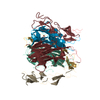
| ||||||||
| Unit cell |
| ||||||||
| Details | Chain D, E, F form a functional trimer Chain J, K, L form a functional trimer |
- Components
Components
| #1: Protein | Mass: 14578.320 Da / Num. of mol.: 6 / Fragment: EXTRACELLULAR DOMAIN Source method: isolated from a genetically manipulated source Source: (gene. exp.)  Homo sapiens (human) / Production host: Homo sapiens (human) / Production host:  #2: Protein | Mass: 19520.852 Da / Num. of mol.: 6 Source method: isolated from a genetically manipulated source Source: (gene. exp.)  Homo sapiens (human) / Production host: Bacteria (eubacteria) / References: UniProt: P50591 Homo sapiens (human) / Production host: Bacteria (eubacteria) / References: UniProt: P50591#3: Chemical | #4: Water | ChemComp-HOH / | Has protein modification | Y | |
|---|
-Experimental details
-Experiment
| Experiment | Method:  X-RAY DIFFRACTION / Number of used crystals: 1 X-RAY DIFFRACTION / Number of used crystals: 1 |
|---|
- Sample preparation
Sample preparation
| Crystal | Density Matthews: 2.6 Å3/Da / Density % sol: 52.71 % | ||||||||||||||||||||||||
|---|---|---|---|---|---|---|---|---|---|---|---|---|---|---|---|---|---|---|---|---|---|---|---|---|---|
| Crystal grow | Temperature: 295 K / Method: evaporation / pH: 4.6 Details: PEG 1000, Sodium Acetate, Sodium Chloride, pH 4.6, EVAPORATION, temperature 22K | ||||||||||||||||||||||||
| Crystal grow | *PLUS pH: 4.5 / Method: unknown | ||||||||||||||||||||||||
| Components of the solutions | *PLUS
|
-Data collection
| Diffraction | Mean temperature: 100 K |
|---|---|
| Diffraction source | Source:  SYNCHROTRON / Site: SYNCHROTRON / Site:  Photon Factory Photon Factory  / Beamline: BL-6A / Wavelength: 1 / Beamline: BL-6A / Wavelength: 1 |
| Detector | Type: FUJI / Detector: IMAGE PLATE / Date: Jan 1, 1999 |
| Radiation | Protocol: SINGLE WAVELENGTH / Monochromatic (M) / Laue (L): M / Scattering type: x-ray |
| Radiation wavelength | Wavelength: 1 Å / Relative weight: 1 |
| Reflection | Resolution: 2.2→20 Å / Num. all: 346386 / Num. obs: 93618 / % possible obs: 89.2 % / Observed criterion σ(F): 1 / Observed criterion σ(I): 1 / Redundancy: 3.7 % / Rmerge(I) obs: 0.061 / Net I/σ(I): 12 |
| Reflection shell | Resolution: 2.2→2.28 Å / Redundancy: 2 % / Rmerge(I) obs: 0.306 / % possible all: 70 |
| Reflection | *PLUS % possible obs: 93.1 % |
| Reflection shell | *PLUS % possible obs: 70 % |
- Processing
Processing
| Software |
| ||||||||||||||||||||
|---|---|---|---|---|---|---|---|---|---|---|---|---|---|---|---|---|---|---|---|---|---|
| Refinement | Resolution: 2.2→8 Å / σ(F): 1 / σ(I): 1 / Stereochemistry target values: Engh & Huber
| ||||||||||||||||||||
| Refinement step | Cycle: LAST / Resolution: 2.2→8 Å
| ||||||||||||||||||||
| Refine LS restraints |
| ||||||||||||||||||||
| Software | *PLUS Name:  X-PLOR / Version: 3.851 / Classification: refinement X-PLOR / Version: 3.851 / Classification: refinement | ||||||||||||||||||||
| Refinement | *PLUS Rfactor Rwork: 0.212 | ||||||||||||||||||||
| Solvent computation | *PLUS | ||||||||||||||||||||
| Displacement parameters | *PLUS Biso mean: 21.81 Å2 |
 Movie
Movie Controller
Controller




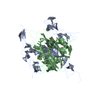

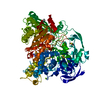
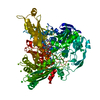

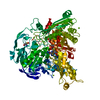
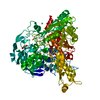
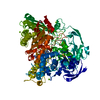
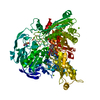
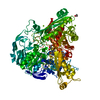
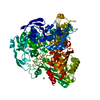
 PDBj
PDBj













